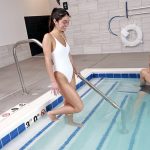It will come as no surprise to anyone that the Super Show resembles little of the show we once knew; the show that once dominated every square inch of the Georgia World Congress Center; the show that turned away exhibitors even as they waved fists full of dollars at the SGMA to give them even a small presence in some out of the way hallway leading to the main action on the show floor. Well, those exhibitors that were once pushed out into the far reaches of the Atlanta venue now find themselves the dominant presence at the current show in Orlando as the larger and more prominent brands exited the show since those gloried days.
What will come as a surprise to many is that we think the Super Show just may have stumbled onto the beginnings of a new formula that will still function as the central gathering place for the U.S. sporting goods industry of the future.
We doubt very much that the title “Super Show” will survive the SGMAs latest attempt to re-build some energy into the event. We doubt very much that Orlando will survive as the chosen venue for any more events after the current contract runs out. And we doubt as well that the show will be able to retain the central core of brands returning this year to prop up the show. We do know that SGMA is not married to the first two items and will do everything in their power to retain the current exhibitor base. One thing we do expect is that SGMA-and newly appointed CEO Tom Cove in particular-are still committed to developing the right platform to give the industry a reason to gather in one place each year.
First, lets take a look at what worked. Based on summary observations and a fairly broad cross-section of input from exhibitors, the hardgoods companies in attendance had a pretty good show. Franklin Sports Larry Franklin even went so far as to say it was one of their best. Perhaps it was the fact that Franklin didnt just create a new product this year, they created a whole new category with their new Battle M.A.X. product. The licensed guys also looked like they had a good show. It was impossible to find a table in the Reebok booth and even the tchotchke vendors were pulling in some interested traffic. And there was the “hot corner” that was impossible to walk through as Under Armour, Russell, Reebok, and New Balance built energy at the northwest section of the hall. But the one piece that clearly worked — and would have worked even better had it been marketed better — was the new International Business Intelligence Series, which featured a broad range of educational seminars and presentations for event attendees. Show Director Peter Haines was almost giddy with the feedback he was getting from people on the program he said was hatched on his kitchen table this last fall.
Unfortunately, the late development of the series left little time to promote the series and had many attendees wondering about how to gain access to the program. The sessions ran the gamut of issues and attendance, from a lightly attended presentation on how the capital market looks at the sporting goods industry to standing-room-only luncheon sessions on the State of the Industry and a Retailers View from the Top. There was also frustration from some management of exhibiting companies that could not find time to get out of the booth and into a seminar they wished to attend. We even found one rep that made the trip to Orlando to attend two days of seminars even though none of his manufacturers were exhibiting at the show.
Add to the success of that part of the show the fact that there are other opportunities that went unrealized by both the SGMA and the exhibitors themselves. We observed that a big miss here was the opportunity to use the show as a vehicle to promote U.S. product to the international market. While many focus on the Asian market as a threat to U.S. manufacturing, others see a new middle class emerging that should be a prime target for U.S. brands. Spalding spent a little energy to promote their presence at the show with their international people and ended up playing host to more than 60 customers from Asia and Australia; customers that may have found a new vendor or two on the show floor. SGMA International should take the lead here. The “International” was added by previous management, but seemed to mean nothing more than an opportunity to travel more and sign up new exhibitors that didnt know any better. We suggest that the real opportunity is putting energy behind attracting the buy-side attendee to benefit those that already exhibit. We suspect that new management may understand the difference.
You may think that we didnt attend the same show you did, or you may say this isnt what you heard about the show. And perhaps its just that those of us that did not have to invest in the expense of exhibiting at Super Show can look at the show through a different lens. The sense we get is that there is something to build on here. Something that cannot — and should not — be lost. But it will take a renewed commitment from a number of vendors and a new focus from the larger retailers to make any venture worthwhile. But first and foremost it will require SGMA and show management to work on a centralized platform for sporting goods commerce and move beyond what we all remember in the heyday of industry growth. For what it is worth, we plan to do everything we can to help develop and support that platform.
















